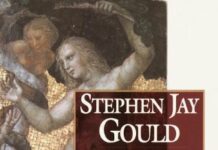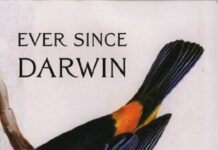
Ebook Info
- Published: 1988
- Number of pages: 222 pages
- Format: PDF
- File Size: 4.73 MB
- Authors: Stephen Jay Gould
Description
Rarely has a scholar attained such popular acclaim merely by doing what he does best and enjoys most. But such is Stephen Jay Gould’s command of paleontology and evolutionary theory, and his gift for brilliant explication, that he has brought dust and dead bones to life, and developed an immense following for the seeming arcana of this field.In Time’s Arrow, Time’s Cycle his subject is nothing less than geology’s signal contribution to human thought—the discovery of “deep time,” the vastness of earth’s history, a history so ancient that we can comprehend it only as metaphor. He follows a single thread through three documents that mark the transition in our thinking from thousands to billions of years: Thomas Burnet’s four-volume Sacred Theory of the Earth (1680–1690), James Hutton’s Theory of the Earth (1795), and Charles Lyell’s three-volume Principles of Geology (1830–1833).Gould’s major theme is the role of metaphor in the formulation and testing of scientific theories—in this case the insight provided by the oldest traditional dichotomy of Judeo-Christian thought: the directionality of time’s arrow or the immanence of time’s cycle. Gould follows these metaphors through these three great documents and shows how their influence, more than the empirical observation of rocks in the field, provoked the supposed discovery of deep time by Hutton and Lyell. Gould breaks through the traditional “cardboard” history of geological textbooks (the progressive march to truth inspired by more and better observations) by showing that Burnet, the villain of conventional accounts, was a rationalist (not a theologically driven miracle-monger) whose rich reconstruction of earth history emphasized the need for both time’s arrow (narrative history) and time’s cycle (immanent laws), while Hutton and Lyell, our traditional heroes, denied the richness of history by their exclusive focus upon time’s arrow.
User’s Reviews
Reviews from Amazon users which were colected at the time this book was published on the website:
⭐Time’s Arrow, Time’s Cycle – Stephen Jay GouldI recently purchased a copy of Martin Rudwick’s The Great Devonian Controversy, but was somewhat intimidated by its size, font and physical layout. To prepare myself mentally I decided to start by reading Stephen Jay Gould’s Time’s Arrow, Time’s Cycle, which I imagined would be a more accessible introduction to some of the issues surrounding the discovery of Deep Time. And it was, although I was surprised to find that Gould’s book is as much pure intellectual history as it is history of science.As others have pointed out, Gould discusses three books written by three different geologists ranging from the 17th to 19th centuries, each describing the geologic history of the Earth from a different perspective. He uses these books to frame the discovery of Deep Time, the idea that Earth’s age is measured not in mere thousands or millions of years, but in fact billions of years. He also uses these books to illuminate a discussion of two distinct world views of the Earth’s geologic history, namely a linear, historical interpretation (Time’s Arrow), versus a cyclical, non-directional interpretation (Time’s Cycle). It is this latter aspect which I refer to as intellectual history. I shouldn’t have been surprised. In his other books, Gould enjoys showing how general overarching principles can shed light on many aspects of the natural world, for example, he has invoked the relationship between volume and surface area to compare the smallest bacteria with the largest Gothic cathedrals. Other classic Gould themes are in evidence, including the rehabilitation of a longed mocked historical figure (Thomas Burnet), and the deflation of a current icon (Charles Lyell). He also shows us that scientists are not flawlessly objective beings who operate on a plane above ordinary mortals, but rather human beings influenced by the preconceptions of their own time and culture.All in all a good read although I am not sure I am any readier to tackle Rudwick.
⭐Does history repeat itself or does it generate a sequence of unique events? This is the fundamental question “Time’s Arrow and Time’s Cycle” asks. It is my third favourite Gould book, after “Wonderful Life” and “Bully for Brontosaurus”. From a literary and philosophical point of view, it’s possibly his best book, being more tightly focused than WL and more developed than the essays in BfB.You’ll find here many standard Gould devices such as fascinating segues and the rehabilitation of discredited thinkers. For instance we read the story of how James Hampton built his masterpiece, his throne to the glory of God, out of discarded junk (it’s now at the Smithsonian). Gould also rehabilitates the 17th century thinker Thomas Burnet and his unsubstantiated cosmological theories. He also presents two more orthodox thinkers, James Hutton and Charles Lyell, and contrasts their gradual uniformitarianism with the sudden catastrophism of Burnet.Gould explicitly dismisses Burnet’s scientific credentials but still uses Burnet’s vision as a starting point. It is by opposing Burnet to Hutton and Lyell that Gould asks the question as to what history is: repetive and uniform, or cyclical? The answer of course is a little of both. Again, Burnet’s vision provides the clue to the answer. There are cycles, and within the cycle there are shocks and catastrophes. Or is it the other way around? Clearly Time is a difficult concept to grasp!Vincent Poirier, Tokyo
⭐Gould teaches on so many levels, how people eventually taught themselves how geological time works. Great science detective work.
⭐The book arrived on time and in good condition. It met all my expectations. I’m teaching a Community College course on Big History. The information in this book was very helpful.
⭐Stephen Jay Gould (1941-2002) wrote many other important books, such as
⭐,
⭐,
⭐,
⭐,
⭐,
⭐,
⭐,
⭐,
⭐,
⭐, etc. [NOTE: page numbers refer to the 222-page paperback edition.]He wrote in the “Acknowledgements” section of this 1987 book, “The genesis of this book lies in the same conflict and interaction of metaphors—arrows of history and cycles of immanence—that fueled the discovery of deep time in geology… this volume is cobbled together from bits and pieces of time’s arrow, quirky and unpredictable moments of my own contingent history… This book is a greatly elaborated and reworked version of the first series of Harvard-Jerusalem lectures, presented at Hebrew University in April 1985.”He states in the first chapter, “Judeo-Christian traditions has struggled to understand time by juggling and balancing two ends of a primary dichotomy about the nature of history… the twin requirements of uniqueness to mark moments of time as distinctive, and lawfulness to established a basis for intelligibility. At one end of the dichotomy—I shall call it time’s arrow—history is an irreversible sequence of unrepeatable events… At the other end—I shall call it time’s cycle—events have no meaning as distinct episodes with causal impact upon a contingent history… Apparent motions are part of repeating cycles, and differences of the past will be realities of the future. Time has no direction.” (Pg. 10-11)In his discussion of Thomas Burnet, he notes, “George McCready Price, grandfather and originator of the pseudoscience known to its adherents by the oxymoron ‘scientific creationism,’ considered Burnet a special threat to his system. Price wished to affirm biblical literalism by an inductive approach based strictly on fieldwork. On the old principle that the enemy within is more dangerous than the enemy without, Price wanted to distance himself as far as possible from men like Burnet, who told their scriptural history of the earth from their armchairs.” (Pg. 23-24)Of James Hutton, he said, “We might still support a weaker version of the empiricist myth if Hutton himself had espoused the mystique of fieldwork, and had attempted later to hide the a priori character of his theory by fudging the derivative character of his crucial observations. At least the ideal would remain intact. Even this version fails before Hutton’s own candor. He presents his theory—with pride—as derived by reason from key premises that have no standing in modern science… He then discusses his observations as subsequent confirmations of these ideas.” (Pg. 72)He observes, “Charles Lyell recognized the link between Hutton and Newton, but he also noted an unhappy comparison—the triumph of cosmology versus the limited success of Hutton’s world machine…. I dedicate this book to a different view of this discrepancy: time’s cycle cannot, in principle, encompass a complex history that bears irreducible signs of time’s arrow. Hutton’s rigidity is both a boon and a trap. It gave us deep time, but we lost rigidity in the process. Any adequate account of the earth requires both.” (Pg. 97)He argues, “If we equate uniformity with truth and relegate the empirical claims of catastrophism to the hush-hush unthinkable of theology, then we enshrine one narrow version of geological process as true a priori, and we lost the possibility of weighing reasonable alternatives… Once we recover Lyell’s substantive objection to intelligible and intelligent catastrophism, we recognize that the real debate was not dogma versus fieldwork, but a conflict between rival empirics rooted in the theme of this book—a conflict of metaphor between time’s cycle and time’s arrow. Lyell was not the white knight of truth and fieldwork, but a purveyor of a fascinating and particular theory rooted in the steady state of time’s cycle. He tried by rhetoric to equate this substantive theory with rationality and rectitude—and he largely triumphed.” (Pg. 114-115) Later, he adds, “I… generally support Lyell’s approach for balancing fact and theory in a complex and imperfect world. I just find it deliciously ironic that cardboard history touts Lyell’s victory as the triumph of fieldwork, while catastrophists were the true champions of a geological record read as directly seen. Lyell, by contrast, urged that theory… be imposed upon the literal record to interpolate within it what theory expected but imperfect data does not provide.” (Pg. 134)Besides being a highly creative evolutionary theorist, Gould was also a brilliant writer and an engaged “public intellectual.” His presence is sorely missed on the scientific and literary scene.
⭐Un grande classico sulla concezione del tempo in Occidente. Il libro mi è anche arrivato un giorno prima della data prevista.
⭐
⭐very good
⭐Great book!
Keywords
Free Download Time’s Arrow, Time’s Cycle: Myth and Metaphor in the Discovery of Geological Time (The Jerusalem-Harvard lectures Book 2) in PDF format
Time’s Arrow, Time’s Cycle: Myth and Metaphor in the Discovery of Geological Time (The Jerusalem-Harvard lectures Book 2) PDF Free Download
Download Time’s Arrow, Time’s Cycle: Myth and Metaphor in the Discovery of Geological Time (The Jerusalem-Harvard lectures Book 2) 1988 PDF Free
Time’s Arrow, Time’s Cycle: Myth and Metaphor in the Discovery of Geological Time (The Jerusalem-Harvard lectures Book 2) 1988 PDF Free Download
Download Time’s Arrow, Time’s Cycle: Myth and Metaphor in the Discovery of Geological Time (The Jerusalem-Harvard lectures Book 2) PDF
Free Download Ebook Time’s Arrow, Time’s Cycle: Myth and Metaphor in the Discovery of Geological Time (The Jerusalem-Harvard lectures Book 2)





